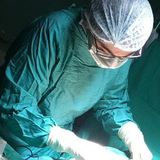


FETAL DEVELOPMENT
Within 24 hours after fertilization, the egg that will become your baby rapidly divides into many cells. By the eighth week of pregnancy, your baby will change names from an embryo to a fetus. There are about 40 weeks to a typical pregnancy. When does a pregnancy start? The start of pregnancy is actually the first day of your last menstrual period. This is called the gestational age, or menstrual age. It’s about two weeks ahead of when conception actually occurs. Though it may seem strange, the date of the first day of your last period will be an important date when determining your baby’s due date. Your healthcare provider will ask you about this date and will use it to figure out how far along you are in your pregnancy. How does conception work? Each month, your body goes through a reproductive cycle that can end in one of two ways. You will either have a menstrual period or become pregnant. This cycle is continuously happening during your reproductive years—from puberty in your teen years to menopause around age 50. In a cycle that ends with pregnancy, there are several steps. First, a group of eggs (called oocytes) gets ready to leave the ovary for ovulation (release of the egg). The eggs develop in small, fluid-filled cysts called follicles. Think of these follicles as small containers for each immature egg. Out of this group of eggs, one will become mature and continue on through the cycle. This follicle then suppresses all the other follicles in the group. The other follicles stop growing at this point. The mature follicle now opens and releases the egg from the ovary. This is ovulation. Ovulation generally happens about two weeks before your next menstrual period begins. It’s generally in the middle of your cycle. After ovulation, the opened (ruptured) follicle develops into a structure called the corpus luteum. This secretes (releases) the hormones progesterone and estrogen. The progesterone helps prepare the endometrium (lining of the uterus). This lining, is the place where a fertilized egg settles to develop. If you don’t become pregnant during a cycle, this lining is what is shed during your period. On average, fertilization happens about two weeks after your last menstrual period. When the sperm penetrates the egg, changes occur in the protein coating of the egg to prevent other sperm from entering. At the moment of fertilization, your baby’s genetic make-up is complete, including its sex. The gender of your baby depends on what sperm fertilizes the egg at the moment of conception. Generally, women have a genetic combination of XX and men have XY. As the mother, you provide each egg with an X. Each sperm can be either an X or a Y. If the fertilized egg and sperm is a combination of an X and Y, it’s a boy. If there are two Xs, it’s a girl. What happens right after conception? Within 24 hours after fertilization, the egg begins rapidly dividing into many cells. It remains in the fallopian tube for about three days after conception. Then the fertilized egg (now called a blastocyte) continues to divide as it passes slowly through the fallopian tube to the uterus. Once there, its next job is to attach to the endometrium. This is called implantation. Before implantation though, the blastocyte breaks out of its protective covering. When the blastocyte makes contact with the endometrium, the two exchange hormones to help the blastocyte attach. Some women notice spotting (slight bleeding) during the one or two days when implantation happens. This is normal and isn’t something you should worry about. At this point, the endometrium becomes thicker and the cervix (the opening between your uterus and birth canal) is sealed by a plug of mucus. Within three weeks, the blastocyte cells ultimately form a little ball, or an embryo. By this time, the baby’s first nerve cells have formed. Your developing baby has already gone through a few name changes in the first few weeks of pregnancy. Generally, your baby will be called an embryo from conception until the eighth week of development. After the eighth week, the baby will be called a fetus until it’s born. How early can I know I’m pregnant? From the moment of conception, the hormone human chorionic gonadotrophin (hCG) will be present in your blood. This hormone is created by the cells that form the placenta (food source for your baby in the womb). It’s also the hormone detected in a pregnancy test. Even though this hormone is there from the beginning, it takes time for it to build within your body. It typically takes three to four weeks from the first day of your last period for the hCG to increase enough to be detected by pregnancy tests. When should I reach out to my healthcare provider about a new pregnancy? Most healthcare providers will have you wait to come in for an appointment until you have had a positive home pregnancy test. These tests are very accurate once you have enough hCG circulating throughout your body. This can be a few weeks after conception. It’s best to call your healthcare provider once you have a positive pregnancy test to schedule your first appointment. When you call, your healthcare provider may ask you if you are taking a prenatal vitamin. These supplements contain something called folic acid. It’s important that you get at least 400mcg of folic acid each day during a pregnancy to make sure your baby’s neural tube (beginning of the baby’s brain and spine) develops correctly. Many healthcare providers suggest that you take prenatal vitamins with folic acid even when you aren’t pregnant. If you weren’t taking prenatal vitamins before your pregnancy, your provider may ask you to start as early as possible. What’s the timeline for my baby’s development? Your baby will change a lot throughout a typical pregnancy. This time is divided into three stages, called trimesters. Each trimester is a set of about three months. Your healthcare provider will probably talk to you about your baby’s development in terms of weeks. So, if you are three months pregnancy, you are about 12 weeks. You will see distinct changes in your baby, and yourself, during each trimester. Traditionally, we think of a pregnancy as a nine-month process. However, this isn’t always the case. A full-term pregnancy is 40 weeks, or 280 days. Depending on what months you are pregnant during (some are shorter and some longer) and what week you deliver, you could be pregnant for either nine months or 10 months. This is completely normal and healthy. Once you get close to the end of your pregnancy, there are several category names you might hear regarding when you go into labor. These labels divide up the last few weeks of pregnancy. They’re also used to look out for certain complications in newborns. Babies that are born in the early term period or before may have a higher risk of breathing, hearing or learning issues than babies born a few weeks later in the full term time frame. When you’re looking at these labels, it’s important to know how they’re written. You may see the week first (38) and then you’ll see two numbers separated by a slash mark (6/7). This stands for how many days you currently are in the gestational week. So, if you see 38 6/7, it means that you are on day 6 of your 38th week. The last few weeks of pregnancy are divided into the following groups: Early term: 37 0/7 weeks through 38 6/7 weeks. Full term: 39 0/7 weeks through 40 6/7 weeks. Late term: 41 0/7 weeks through 41 6/7 weeks. Post term: 42 0/7 weeks and on. Talk to your healthcare provider about any questions you may have about your baby’s gestational age and due date. Stages of Growth Month-by-Month in Pregnancy First trimester The first trimester will span from conception to 12 weeks. This is generally the first three months of pregnancy. During this trimester, your baby will change from a small grouping of cells to a fetus that is starting to have a baby’s features. Month 1 (weeks 1 through 4) As the fertilized egg grows, a water-tight sac forms around it, gradually filling with fluid. This is called the amniotic sac, and it helps cushion the growing embryo. During this time, the placenta also develops. The placenta is a round, flat organ that transfers nutrients from the mother to the baby, and transfers wastes from the baby. Think of the placenta as a food source for your baby throughout the pregnancy. In these first few weeks, a primitive face will take form with large dark circles for eyes. The mouth, lower jaw and throat are developing. Blood cells are taking shape, and circulation will begin. The tiny "heart" tube will beat 65 times a minute by the end of the fourth week. By the end of the first month, your baby is about 1/4 inch long – smaller than a grain of rice. Month 2 (weeks 5 through 8) Your baby's facial features continue to develop. Each ear begins as a little fold of skin at the side of the head. Tiny buds that eventually grow into arms and legs are forming. Fingers, toes and eyes are also forming. The neural tube (brain, spinal cord and other neural tissue of the central nervous system) is well formed now. The digestive tract and sensory organs begin to develop too. Bone starts to replace cartilage. Your baby’s head is large in proportion to the rest of its body at this point. At about 6 weeks, your baby's heart beat can usually be detected. After the 8th week, your baby is called a fetus instead of an embryo. By the end of the second month, your baby is about 1 inch long and weighs about 1/30 of an ounce. Month 3 (weeks 9 through 12) Your baby's arms, hands, fingers, feet and toes are fully formed. At this stage, your baby is starting to explore a bit by doing things like opening and closing its fists and mouth. Fingernails and toenails are beginning to develop and the external ears are formed. The beginnings of teeth are forming under the gums. Your baby's reproductive organs also develop, but the baby's gender is difficult to distinguish on ultrasound. By the end of the third month, your baby is fully formed. All the organs and limbs (extremities) are present and will continue to develop in order to become functional. The baby’s circulatory and urinary systems are also working and the liver produces bile. At the end of the third month, your baby is about 4 inches long and weighs about 1 ounce. Since your baby's most critical development has taken place, your chance of miscarriage drops considerably after three months. Second trimester This middle section of pregnancy is often thought of as the best part of the experience. By this time, any morning sickness is probably gone and the discomfort of early pregnancy has faded. The baby will start to develop facial features during this month. You may also start to feel movement as your baby flips and turns in the uterus. During this trimester, many people find out the sex of the baby. This is typically done during an anatomy scan (an ultrasound that checks your baby’s physical development) around 20 weeks. Month 4 (weeks 13 through 16) Your baby's heartbeat may now be audible through an instrument called a doppler. The fingers and toes are well-defined. Eyelids, eyebrows, eyelashes, nails and hair are formed. Teeth and bones become denser. Your baby can even suck his or her thumb, yawn, stretch and make faces. The nervous system is starting to function. The reproductive organs and genitalia are now fully developed, and your doctor can see on ultrasound if you are having a boy or a girl. By the end of the fourth month, your baby is about 6 inches long and weighs about 4 ounces. Month 5 (weeks 17 through 20) At this stage, you may begin to feel your baby moving around. Your baby is developing muscles and exercising them. This first movement is called quickening and can feel like a flutter. Hair begins to grow on baby's head. Your baby's shoulders, back and temples are covered by a soft fine hair called lanugo. This hair protects your baby and is usually shed at the end of the baby's first week of life. The baby's skin is covered with a whitish coating called vernix caseosa. This "cheesy" substance is thought to protect your baby's skin from the long exposure to the amniotic fluid. This coating is shed just before birth. By the end of the fifth month, your baby is about 10 inches long and weighs from 1/2 to 1 pound. Month 6 (weeks 21 through 24) If you could look inside the uterus at your baby right now, you would see that your baby's skin is reddish in color, wrinkled and veins are visible through the baby's translucent skin. Baby's finger and toe prints are visible. In this stage, the eyelids begin to part and the eyes open. Baby responds to sounds by moving or increasing the pulse. You may notice jerking motions if baby hiccups. If born prematurely, your baby may survive after the 23rd week with intensive care. By the end of the sixth month, your baby is about 12 inches long and weighs about 2 pounds. Month 7 (weeks 25 through 28) Your baby will continue to mature and develop reserves of body fat. At this point, the baby's hearing is fully developed. The baby changes position frequently and responds to stimuli, including sound, pain and light. The amniotic fluid begins to diminish. If born prematurely, your baby would be likely to survive after the seventh month. At the end of the seventh month, your baby is about 14 inches long and weighs from 2 to 4 pounds. Third trimester This is the final part of your pregnancy. You may be tempted to start the countdown till your due date and hope that it would come early, but each week of this final stage of development helps your baby prepare for childbirth. Throughout the third trimester, your baby will gain weight quickly, adding body fat that will help after birth. Remember, even though popular culture only mentions nine months of pregnancy, you may actually be pregnant for 10 months. The typical, full-term pregnancy is 40 weeks, which can take you into a tenth month. It’s also possible that you can go past your due date by a week or two (41 or 42 weeks). Your healthcare provider will monitor you closely as you approach your due date. If you pass your due date, and don’t go into spontaneous labor, your provider may induce you. This means that medications will be used to make you go into labor and have the baby. Make sure to talk to your healthcare provider during this trimester about your birth plan. Month 8 (weeks 29 through 32) Your baby will continue to mature and develop reserves of body fat. You may notice that your baby is kicking more. Baby's brain is developing rapidly at this time, and your baby can see and hear. Most internal systems are well developed, but the lungs may still be immature. Your baby is about 18 inches long and weighs as much as 5 pounds. Month 9 (weeks 33 through 36) During this stage, your baby will continue to grow and mature. The lungs are close to being fully developed at this point. Your baby's reflexes are coordinated so he or she can blink, close the eyes, turn the head, grasp firmly, and respond to sounds, light, and touch. Your baby is about 17 to 19 inches long and weighs from 5 ½ pounds to 6 ½ pounds. Month 10 (Weeks 37 through 40) In this final month, you could go into labor at any time. You may notice that your baby moves less due to tight space. At this point, your baby’s position may have changed to prepare for birth. Ideally, the baby is head down in in your uterus. You may feel very uncomfortable in this final stretch of time as the baby drops down into your pelvis and prepares for birth. Your baby is ready to meet the world at this point. Your baby is about 18 to 20 inches long and weighs about 7 pounds.
Source: https://images.app.goo.gl/Pmwo3uCEMfv4m7v8AGreat sir/madam veryy useful and clarified information, big applause for ur patience,



